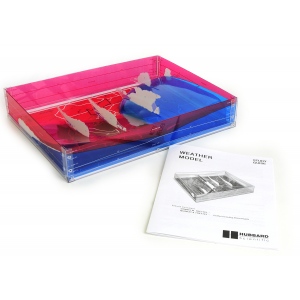LDEO NGSS Summer Institutes: “Teaching about Weather and Climate” (GED 7212)
Lesson 5 – “Forecasting Weather—Air Masses, Front, Pressure Systems”
Expected Time Required: 3 -4 hrs
Submitted by: Date: Time Needed:
DOWNLOAD a Word VERSION DOWNLOAD a pdf VERSION
Most people are only interested in knowing from a weather forecast whether it will be “Hot/Cold/Wet/Dry.” You and your students should know more about what causes the weather and how accurate the National Weather Service and other forecasters can be. In these activities, you will learn about the basic causes of weather and how it can be forecast.
-
-
-
Review the “Weather Basics” slide show.
https://earth2class.org/site/wp-content/uploads/2015/06/Weather-Basics.pdf
-
-
Then complete the “Cornell-style notes” about “Air Masses, Fronts, and Pressure Systems”
pdf version Word doc
-
-
Accurate forecasting depends on collection of simultaneous and massive amounts of observations from hundreds or monitoring stations. These data are then transformed by computers into maps and other visualizations that can be easily interpreted.
Read about Synoptic Meteorology in the NWS “JetStream—An Online School for Weather”.
Discuss strategies to use this and/or other topics in the NWS JetStream website for your lesson plans.
-
One of the most effective hands-on manipulatives I have found to teach about weather forecasting is the “Hubbard Weather Model” (see below).
It can be purchased from Scott Resources & Hubbard Scientific. (It is also available from other suppliers for a wide range of prices. )

UNDERSTANDING “WEATHER-MAKER” PATTERNS WITH THE “HUBBARD WEATHER MODEL” teaches about the basic causes for weather—air masses, fronts, and pressure systems. The final part provides the opportunity to try to predict what weather conditions will be at the six selected locations as the system moves toward the Northeast.
If you do not have access to the physical model, you can complete the activity using these:
Images to Accompany the Hubbard Wx Model [ppt version].
-
There are many ways to obtain a weather forecast—apps, websites, radio, TV, among others. But the official issuer of forecasts is the National Weather Service (NWS), weather.gov (This should not be confused with weather.com, The Weather Channel, who get most of their data from the NWS and then package it for their broadcasts.)
The NWS wants your help to create a “Weather Ready Nation”!
 First, look at the current NWS home page, www.weather.gov.What parts of this would be of most use to you in creating your weather forecast lesson plans?Next, click on “FORECAST” on the top bar. Explore some of the options in the pull-down menu. What parts of this would be of most use to you in creating your weather forecast lesson plans?
First, look at the current NWS home page, www.weather.gov.What parts of this would be of most use to you in creating your weather forecast lesson plans?Next, click on “FORECAST” on the top bar. Explore some of the options in the pull-down menu. What parts of this would be of most use to you in creating your weather forecast lesson plans?Then open the “FORECAST MAPS” in the middle of the page. Explore these and describe how you might incorporate them into lesson plans.
Go back to the NWS home page and select a location for “Local forecast” in the upper left. Discuss how you might use the information that is provided to create lesson plans.
5. Emergency Forecasts
You probably would not monitor the weather 24/7, but “bad things” can happen at any time. So one of the best ways to obtain a forecast of imminent dangerous conditions, as well as normal weather, is through the NOAA WEATHER RADIO system. These can be set so that a warning alarm will sound whenever important information needs to get out to the public and emergency responders.Examine the information provided on this site and explain how you could use it to create a lesson plan.
Several years ago, the NWS distributed thousands to schools across the country. These have been very useful in making decisions about sports and other outdoor events. Find out if your school or district office has a NOAA Weather Radio. If not, discuss with the appropriate administrator about how they should obtain one.

If you do a lot of outdoor activities, you should have your own NOAA Weather Radio.
6. What else might you wish to include in a unit about weather forecasting?

